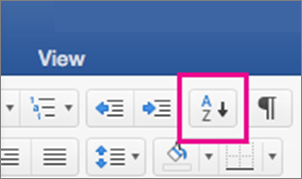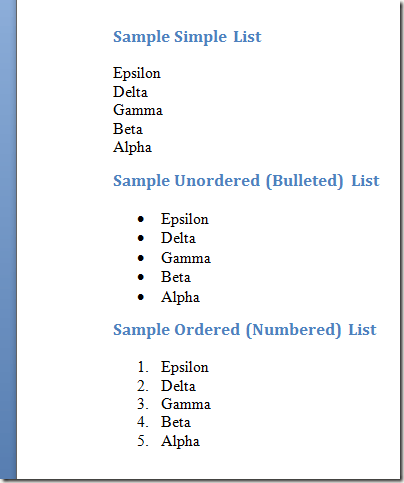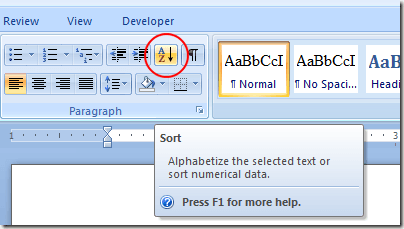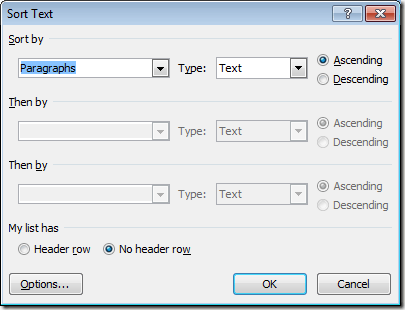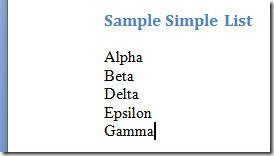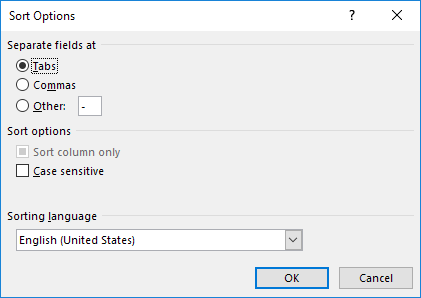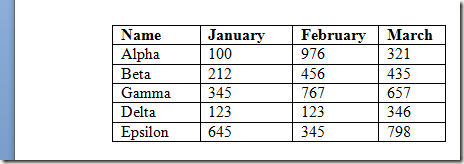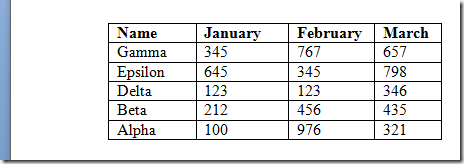-
Select the list you want to sort.
-
Go to Home > Sort.
-
Set Sort by to Paragraphs and Text.
-
Choose Ascending (A to Z) or Descending (Z to A).
-
Select OK.
-
Select the list you want to sort.
-
On the Home tab, click Sort.
-
In the Sort Text dialog box:
-
Under Sort by, select Paragraphs.
-
Next to Type, select Text.
-
Choose Ascending or Descending.
-
-
Click OK.
With Word for the web you can create numbered and bulleted lists, but you can’t sort lists alphabetically. You can sort lists alphabetically in the desktop version of Word.
If you have Word, select Open in Word.
Then follow the instructions in the Windows tab.
When most people think of sorting text in an application, they think of sorting cells in an Excel spreadsheet. However, you can sort text in Word as long as there is something that tells Word where the different parts of text begin and end.
In this article, I’ll show you a couple of ways you can sort text, lists and tables in Word. Note that if you already have data in Excel, you can easily insert an Excel spreadsheet into your Word document.
Sorting Lists in Word
There are three types of lists you can sort in Word. The first kind is simply a list of words or phrases that each occupies a separate line. The second type is unordered or bulleted lists. The third is ordered or numbered lists.
In each of these cases, a line break (also called a carriage return) tells Word where one word or phrase ends and the next one begins. This is how Word is able to sort text in the document.
To sort any of these types of lists, begin by selecting the list with your mouse. Simply start at the beginning of the list, hold down the left mouse button, and drag your mouse until the entire list is selected.
Then, click on the Home tab on the Ribbon and locate the section titled Paragraph. Look for a button with the letters A and Z on it and an arrow pointing down. This is the Sort command. Click on the Sort button and Word will open the Sort Text window.
On the Sort Text window, you’ll notice that there a number of options. First, you need to indicate that you want to sort the text you’ve selected by paragraph. Even though we only have one word per line, Word still considers each line to be its own paragraph because we pressed the enter key to get to the next line. Sorting by paragraph is the default option.
Next we need to tell Word what we are sorting. Locate the drop down menu labeled Type and choose Text. This is also the default option.
Lastly, we need to tell Word whether we want to sort the text in ascending (A to Z) order or descending order (Z to A). Ascending order is the default option. When done, click the OK button and Word will sort your text with the options you chose.
Notice that now the text is sorted from A to Z in ascending order. In addition, if you click on the Options button, you can configure advanced settings like the field separator and whether it should be case sensitive or not.
Sorting Text in Tables
This type of sorting may seem a bit more familiar to you if you often sort data in Excel. Much like an Excel worksheet, a table contains rows, columns, and may contain headings in the first row. Luckily, Word gives you much of the same flexibility to sort text as found in Excel.
Suppose you have a table in Word that looks like the one below.
Notice that there are column headings in the first row and that the first column contains the text we wish to sort. Let’s assume that we want to sort the data in descending order this time. Select the entire table and once again click on the Sort button in the Paragraph section of the Ribbon.
Notice in the bottom left hand corner of the Sort window that Word has already detected the headings in the first row. Notice also that the first Sort By drop down menu already has the column heading Name in the option box.
The rest of the options stay the same except remember to change the sort direction to Descending. When done, click the OK button and Word will sort the table using the options we’ve chosen.
Sorting text in Word is simple as long as you have a way to tell Word what separates one data element from the next. If you play with the sort settings a bit, you will discover that you can sort using multiple columns and even tab and comma delimited text in a Word document.
Although not as useful as sorting data in Excel, you can save yourself some time in Word by having the application sort paragraph and table text for you using a similar interface as found in an Excel worksheet. Enjoy!
Word supports simple and multi-level sorts for tabular data
Updated on December 4, 2022
What To Know
- Lists: Select the list. Go to Home > Sort. Pick Paragraph in Sort By and Text in Type. Choose either Ascending or Descending, and press OK.
- Tables: Under Layout, go to Data > Sort. Pick Header Row in My List Has, the column in Sort By, Text in Type, and Asc. or Desc. Press OK.
- Advanced: Select Column 1 and Sort By. Then, select Column 2 and Then By. Press OK. Select Options for more sorting controls.
This article explains how to alphabetize in Word, so you can save you loads of time and effort when you want to sort, organize, or classify text in tables, lists, or columns. These instructions apply to Word 2019, Word 2016, Word 2013, Word for Microsoft 365, Word 2016 for Mac, and Word for Microsoft 365 for Mac.
How to Alphabetize a List in Word
Sort any list in alphabetic or reverse alphabetical order with little more than a few clicks of the mouse.
-
Select the text of your list.
-
From the Home tab, select Sort to open the Sort Text box.
Sorting in Word is simple.
-
Choose Paragraphs in the Sort By box and choose Text in the Type box.
-
Select Ascending (A to Z) or Descending (Z to A).
-
Then, press OK.
If you alphabetize a numbered list, the sorted list will remain numbered correctly.
This process will not sort a multilevel list properly.
How to Sort a Table Alphabetically
The process of sorting a table alphabetically is similar to sorting a list.
-
From the Layout tab, find the Data section, then select Sort to open the Sort dialog box. This dialog box supports several options.
-
Select Header Row under My List Has at the bottom of the box if your table has a header row. This setting prevents Word from including your headers in the sort process.
-
Choose the name of the column by which you want to sort the table in the Sort By list.
The Table Tools tab helps alphabetize in Word.
-
Choose the way you want to sort the table in the Type list. To sort alphabetically, choose Text.
-
Select Ascending or Descending to select the sort order.
-
Click OK to sort the table.
Advanced Table Sorting
Word supports multi-level sorting—a helpful feature if a primary sort column includes duplicate values.
-
Select Column 1 in the Sort By list of the Sort dialog box.
Sort by multiple columns in a Word table.
-
Select Column 2 in the Then By list.
-
Select OK to sort the table.
-
Select Options in the Sort dialog box for other advanced options. For example, sort text alphabetically using tabs, commas, or other separators; make the sort case sensitive; choose the language you want to use to sort text alphabetically in Word.
FAQ
-
How do I sort a table in ascending order in Word?
Select the table and go to Table Design > Layout > Sort. Choose whether or not your data has headers. Next to Sort by, choose how you want to sort (name or column) and what type of data it is (text, number, or date). Select Ascending as your sort order.
-
How do I make a table in Word?
To insert a table in Word, place your cursor where you want the table to appear and select Insert > Table > drag over the cells to select how many columns and rows you want.
-
How do I add a row to a table in Word?
Click in the table where you want the row > right-click > Insert > select Insert Rows Above or Insert Rows Below.
Thanks for letting us know!
Get the Latest Tech News Delivered Every Day
Subscribe
Download Article
Download Article
Alphabetizing lists is a good skill to learn in word, especially if you find yourself dealing with directories and lists often. Luckily, the sorting process is quite simple once you learn how to access it. Follow this guide to learn how for any version of Word.
-
1
Open the file that you want to sort. You can also copy and paste the list of words that you want to sort into a document. In order to alphabetize the words, they need to be formatted as a list, with each entry on its own line.
-
2
Select the text that you want to sort. If your list is the only part of your document, you don’t need to highlight anything. If you want to alphabetize a list that is part of a larger document, highlight the section that you want to sort.
Advertisement
-
3
Click the Home tab. In the Paragraph section of the Home tab, click the Sort button. The icon is an “A” above a “Z” with an arrow pointing down. This will open the Sort Text dialogue box.[1]
-
4
Choose your order. By default, the sorting will happen by paragraph. Click the Ascending or Descending button to select which order the list should appear. Ascending will put the list in alphabetical order, and Descending will put the list in reverse alphabetical order.
- If you want to sort by the second word for each entry (for example, by last name in a FIRST, LAST format), click the Options button in the Sort Text window. In the “Separate fields by” section, select Other and enter a single space. Press OK, and then select Word 2 in the Sort By menu. Press OK to sort the list.[2]
- If you want to sort by the second word for each entry (for example, by last name in a FIRST, LAST format), click the Options button in the Sort Text window. In the “Separate fields by” section, select Other and enter a single space. Press OK, and then select Word 2 in the Sort By menu. Press OK to sort the list.[2]
Advertisement
-
1
Open the file that you want to sort. You can also copy and paste the list of words that you want to sort into a document. In order to alphabetize the words, they need to be formatted as a list, with each entry on its own line.
-
2
Select the text that you want to sort. If your list is the only part of your document, you don’t need to highlight anything. If you want to alphabetize a list that is part of a larger document, highlight the section that you want to sort.
-
3
Click the Table menu. Select Sort. This will open the Sort Text dialogue box.
-
4
Choose your order. By default, the sorting will happen by paragraph. Click the Ascending or Descending button to select which order the list should appear. Ascending will put the list in alphabetical order, and Descending will put the list in reverse alphabetical order.
- If you want to sort by the second word for each entry (for example, by last name in a FIRST, LAST format), click the Options button in the Sort Text window. In the “Separate fields by” section, select Other and enter a single space. Press OK, and then select Word 2 in the Sort By menu. Press OK to sort the list.
Advertisement
Add New Question
-
Question
How can I alphabetize a list of names?
From the Home section, go to the Paragraph subsection. From there, to Alphabetize text, go to
Home > Paragraph>A
Z↓ -
Question
I have followed these steps, but I press «OK» and nothing happens. What can I do?
Once you have pressed the «Sort Text» button on Word, it has the «Sort By» area unshaded. Select the options you want, for example «Headings» in drop box 1, «Text» in drop box 2, and then click on the «Descending» button. It is normally already selected as «Ascending.» Click «OK» and it should alphabetize.
-
Question
How do I alphabetize an address list?
Capitalize the first letter of every word, making sure to capitalize both letters of the state. For example : 12345 Street, City, AZ, 12345.
Ask a Question
200 characters left
Include your email address to get a message when this question is answered.
Submit
Advertisement
Video
-
You may need to click on the arrow pointing down at the bottom of an MS Word menu (such as the Table menu) in order to expand the menu and see all of the options.
-
You can use MS Word as a sorting tool to alphabetize text in any software that allows you to paste text. Just alphabetize in Microsoft Word first and then copy the sorted list and paste it at other destinations.
Thanks for submitting a tip for review!
Advertisement
About This Article
Article SummaryX
1. Select the text.
2. Click the Home tab.
3. Click the «AZ» button with the down-arrow.
Did this summary help you?
Thanks to all authors for creating a page that has been read 655,274 times.


